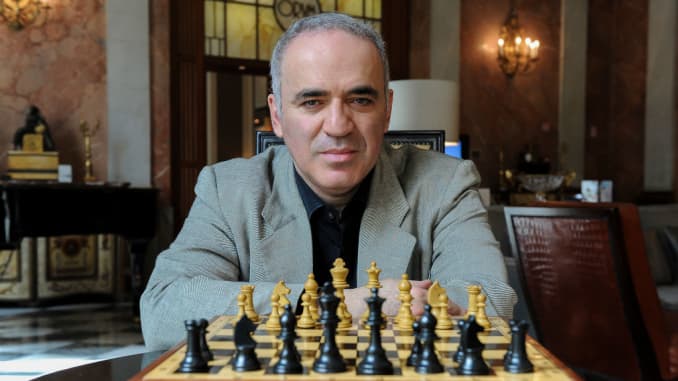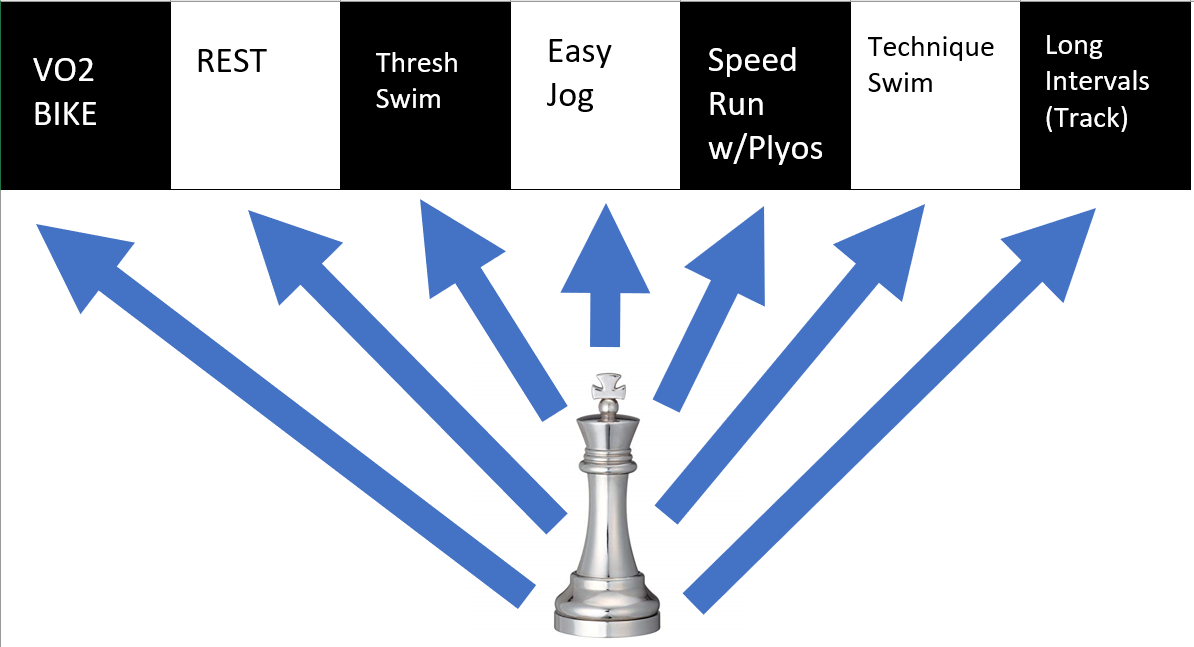Planning your season like a Chess Grand Master
Alan Couzens, M.Sc.(Sports Science)
Dec 26, 2019

“The stock market and the gridiron and the battlefield aren’t as tidy as the chessboard, but in all of them, a single, simple rule holds true: make good decisions and you’ll succeed; make bad ones and you’ll fail.” – Garry Kasporov
Apologies for my absence. Life has been busy of late. The best possible kind of busy, though. I have been consumed by a new venture, a new mission of building the first true Artificial Intelligence coaching engine.
Developing the intelligence behind the platform has been an equally difficult and enlightening experience…. by design. While it would have been easy to 'hard code' my domain knowledge into a set of rules, the team made a deliberate decision to elect for the far more difficult route of building a machine that truly learns. As we have progressed further along this route, I have become more and more satisfied that this is the right option to take for a task as complex as coming up with an optimal training plan. And the source of this realization really comes down to one very important word… Flexibility.
I am not a great chess player. I have dabbled a little over the years, though, enough to get a feel for the process of learning the game. Initially, when I was first learning how to play, I remember adopting a largely random strategy. Keeping the rules of the game in mind was enough of a task that any strategy was secondary. So long as an action was legal, it was worth a try! Surprisingly enough, this “pick a random action” approach generally resulted in me losing the game 😊 So, after getting frustrated enough, I started reading about more effective strategies. I started to read about text book "openings" – a sequence of moves that, all going right, theoretically had a high probability of leading to a check mate. And sure enough, my win rate improved. However, I noticed one thing – the further along a game proceeded, the less predictable it became & the less useful this ‘canned plan’ of play was. Computers learned this too...
Cranking my chess development up a level, I turned to the family PC – our trusty VZ300. As I played many games against the computer, it became readily apparent that the machine kept repeating a handful of preprogrammed strategies over and over again. Because it adopted the plan of repeating a handful of “textbook” strategies, it easily became confused when it encountered a situation outside of its pre-programmed plan. The computer chess programmers quickly realized these limitations and adopted a different approach at the competition level:
They stopped 'hard-coding' a strategy & instead, taught the computer to think move by move.
The success of this approach became clear when IBM’s Deep Blue defeated Chess legend, Garry Kasparov in 1996. Rather than having a handful of encoded strategies, Deep Blue played the game move by move and ran through a “brute force” search of the consequences of all possible moves to determine the best move to make. This approach of learning by simulating the effects of decisions clearly worked better than the old approach of having a set pre-programmed strategy for one simple reason: The chess environment is unpredictable & not entirely under the player’s control! This stochastic characteristic of the environment not being entirely predictable or under the player’s control will probably sound familiar to you, the athlete 😊
Over the course of a training season, stuff happens. Stuff that we, in no way shape or form, would have been able to predict at the start of the season & yet, every year, about this time most of us sit down and open our favorite 'ATP builder' and spend hours crafting the “perfect" Annual Plan If I just do x% more of this at week 22, and y% more of that at week 41, I’m sure to win the game (qualify for Kona, win my age group etc). Of course, it rarely pans out at week 22 and week 41 exactly as we had envisioned and so all of our beautifully planned moves amount to nought.
So, what is the alternative? A return to the chaotically random planning of my young chess playing days? 😊 No, as Deep Blue (& its Deep Learning successors) learned, the best route is to play adaptively, i.e. while keeping the long term in view, to continually assess the actual current state of the system and to make the best decision possible based upon that state! This approach is further explained below…

On any given day, the athlete, just like the chess player, has a wide number of potential moves they can make. The right move to make ultimately comes down to what the rest of the ‘board’ looks like at that time, i.e. what state the athlete finds him/herself in on that day. The right action to take will be different if the King is under heavy attack vs if the board is wide open. Similarly, for the athlete, the right action to take when the athlete is tired from a stressful day at the office and exhibiting low HRV numbers will be different to the right action when the athlete is well rested and feeling great. If the player continues with their rote plan irrespective of how the board is moving around him/her, it is a matter of time before they find themselves in a losing position...
While most moves, especially in the early game, are not fatal, it is the cumulative addition of each of these small decisions that determines whether the athlete will win or lose the game.
Thankfully, in this day and age, there are many ways that we can assess the state of the system & the consequent best move to make: Using tools like Heart Rate Variability, subjective wellness questionnaires, comparison of internal to external load all offer a window into your current game state & whether you, the athlete, are in a ‘winning position’. They also give you important information on whether you should adopt an offensive or defensive strategy in the coming moves.

The advantages to this 'adaptive' approach in the field of sports training have already been demonstrated in a number of studies. For example, Kiviniemi et al. (2007), compared an adaptive HRV guided approach (illustrated left) to a traditional periodization approach in endurance athletes and found a 4x greater change in VO2peak over a four week period when a flexible HRV guided approach was used over a rigid pre-planned approach! These impressive results in favor of adaptive planning have since been replicated in a number of follow up studies (Vesterinen et al., 2016, Nuutilla et al., 2017, Da Silva et al., 2019)
Of course, HRV only represents one small aspect of the ‘game board’. Including other metrics to describe the current state of the athlete (power v heart rate data, subjective feeling, sleep quality etc. all add extra dimensionality to better describe the athlete’s state). All of these state descriptors (& more) are included in our models. In addition, the number of potential actions available to an athlete, especially the triathlete, extends beyond the simple High, Medium, Low intensity sessions. In practice we must account for multiple sports, multiple reps, multiple rep distance variations, multiple rest variations etc. The addition of all possible actions significantly increases the complexity of the graph. In this venture, we are using state of the art Deep Learning approaches to overcome these issues.
While there is significant power in this simple approach of looking at what the likely consequence of an action will be based on the current physiological state of the athlete, Deep Blue & its successors – Houdini, Deep Fritz &, in the more challenging domain of Go, AlphaGo, proceed a step (or actually, several thousand steps) beyond that, in that they have the computing power to look many, many moves ahead. They can build a massive database of different state-action 'maps' and whether they resulted in a 'win' or a 'loss' & then use this map to simulate the effect of any given action on any given day. This ability is what we aim to bring to you, the athlete, with the computing power available in 2020.
This adaptive "next move" approach represents a marked paradigm shift from sitting down at the start of the season & crafting a rigid plan. If adopted, however, you, like Deep Blue before you, will quickly see the advantage that this flexible approach brings. To paraphrase Kasparov, the difference between a good and bad season will ultimately come down to a sequence of good or bad daily decisions.
Train smart,
AC
TweetDon't miss a post! Sign up for my mailing list to get notified of all new content....
